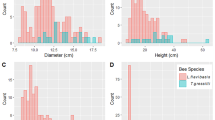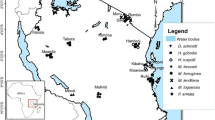Abstract
Stingless bees play a key role in natural environments and human economy because of their pollination services and high-value products. However, information on their nesting habitats and nest characteristics is scarce for almost all Ethiopian stingless bee species. To gain insights into the nest ecology and biology of stingless bees in the country, different habitats from 11 districts were assessed and general nest properties, such as entrance dimension, shape, entrance tunnel length, nest size, nesting substrate and internal nest architecture, were characterized. A total of 49 natural nests of two stingless bee species belonging to two genera: Meliponula and Liotrigona were found. The 47 nests of Meliponula baccarii (M. baccarii) (Gribodo) were found under the ground at an average depth of 50.50 ± 9.32 cm in three different soil types, while the two nests of Liotrigona bottegoi (L. bottegoi) were found in the cavities of Albizia shimperiana trunks at the heights of 2.8 and 3.0 m above the ground. Nest architecture and biology differed greatly between species but similar within each. Though the basic nest architecture and biology were similar within the species, they varied in size from nest to nest. The above characteristics therefore can be used for the management and conservation of the species. Finally, the data on nesting substrates, nest architecture and nest biology are of outmost importance for future designing suitable bee hives for keeping both species and also to conserve the natural nesting sites for their future utilization in pollination.




Similar content being viewed by others
Availability of data and material
Not applicable.
Code availability
Not applicable.
References
Alves RMDO, Waldschmidt AM, Paixão JF, Santos DR, Carvalho CAL (2019) Geographic range and nest architecture of Cephalotrigona capitata smith, 1854 (Apidae: Meliponini) in the state of Bahia, Northeastern Brazil. J Apic Sci 63:49–60. https://doi.org/10.2478/JAS-2019-0006
Ashenafi M (1994) The in vitro antibacterial activity of “tazma mar” honey produced by the stingless bee (Apis mellipodae). Ethiop J Heal Dev 8:109–117. Available at: https://www.ajol.info/index.php/ejhd/article/view/216727
Barbosa FM, Alves RM, Souza BD, Carvalho CA (2013) Nest architecture of the stingless bee Geotrigona subterranea (Friese 1901 (Hymenoptera: Apidae: Meliponini). Biota Neotrop 13:147–152. https://doi.org/10.1590/S1676-06032013000100017
Bayeta AG, Hora ZA (2021) Evaluation of different hive designs for domestication and conservation of native stingless bee (Apidae: Meliponula beccarii) in Ethiopia. Int J Trop Insect Sci 41:1791–1798. https://doi.org/10.1007/s42690-020-00392-5
Biesmeijer JC, Giurfa M, Koedam D, Potts SG, Joel DM, Dafni A (2005) Convergent evolution: Floral guides, stingless bee nest entrances, and insectivorous pitchers. Naturwissenschaften 92:444–450. https://doi.org/10.1007/s00114-005-0017-6
Chemurot M, Otim AS, Namayanja D, Onen H, Angiro C, Mugume R, Kajobe R, Macharia J, Gikungu M, Abila PP, Kasangaki P (2021) Stingless beekeeping in uganda: an industry in its infancy. African Entomol 29:165–172. https://doi.org/10.4001/003.029.0165
Cortopassi-Laurinoa M, Imperatriz-Fonsecab VL, Roubikc DW, Dollind A, Hearde T, Aguilarf I, Venturieri GC, Eardley C, Nogueira-Neto P (2006) Global meliponiculture: challenge opportunities 37:275–292
Couvillon MJ, Wenseleers T, Imperatriz-Fonseca VL, Nogueira-Neto P, Ratnieks FLW (2008) Comparative study in stingless bees (Meliponini) demonstrates that nest entrance size predicts traffic and defensivity. J Evol Biol 21:194–201. https://doi.org/10.1111/j.1420-9101.2007.01457.x
Danaraddi CS, Shashidhar V, Basavanagoud K, Bhat AR (1996) Nesting habits and nest structure of stingless bee, Trigona iridipennis Smith at Dharwad, Karnataka. Karnataka J Agric Sci 22:310–313. Available at: https://www.cabdirect.org/cabdirect/abstract/20093330538
Eardley CD (2004) Taxonomic revision of the African stingless bees ( Apoidea : Apidae : Apinae : Meliponini ). African Plant Prot 10:63–96
Gela A, Hora ZA, Kebebe D, Gebresilassie A (2021) Physico-chemical characteristics of honey produced by stingless bees (Meliponula beccarii) from West Showa zone of Oromia Region, Ethiopia. Heliyon 7:e05875. https://doi.org/10.1016/j.heliyon.2020.e05875
Gonzalez VH, Amith JD, Stein TJ (2018) Nesting ecology and the cultural importance of stingless bees to speakers of Yoloxóchitl Mixtec, an endangered language in Guerrero, Mexico. Apidologie 49:625–636. https://doi.org/10.1007/s13592-018-0590-2
Grüter C, Kärcher MH, Ratnieks FLW (2011) The natural history of nest defence in a stingless bee, Tetragonisca angustula (Latreille) (Hymenoptera: Apidae), with two distinct types of entrance guards. Neotrop Entomol 40:55–61. https://doi.org/10.1590/S1519-566X2011000100008
Jemberie W, Negash W, Alemu K, Tarekegn A, Brhan M, Raja N (2020) Stingless bee Meliponula Cockerell (Hymenoptera: Apidae: Meliponini) ground nest architecture and traditional knowledge on the use of honey in the Amhara Region, Northwest Ethiopia. Isr J Entomol 50:14–17. https://doi.org/10.5281/zenodo.4588315
Kajobe R (2007) Nesting biology of equatorial Afrotropical stingless bees (Apidae; Meliponini) in Bwindi Impenetrable National Park. Uganda J Apic Res 46:245–255. https://doi.org/10.3896/ibra.1.46.4.07
Kajobe R, Roubik DW (2006) Honey-making bee colony abundance and predation by apes and humans in a Uganda forest reserve. Biotropica 38:210–218. https://doi.org/10.1111/j.1744-7429.2006.00126.x
Kelly N, Farisya MSN, Kumara TK, Marcela P (2014) Species diversity and external nest characteristics of stingless bees in meliponiculture. Pertanika J Trop Agric Sci 37:293–298
Kidane AA, Tegegne FM, Tack AJM (2021) Indigenous knowledge of ground-nesting stingless bees in southwestern Ethiopia. Int J Trop Insect Sci. https://doi.org/10.1007/s42690-021-00442-6
Melo GAR, Costa MA (2009) Uma nova espécie de Plebeia (Hymenoptera, Apidae) do leste do Brasil, com células de cria em cacho. Rev Bras Entomol 53:77–81. https://doi.org/10.1590/S0085-56262009000100019
Michener CD (2007) The bees of the world. The Johns Hopkins University Press, Baltimore
Moritz RFA, Crewe RM (1988) Air ventilation in nests of two African stingless bees Trigona denoiti and Trigona gribodoi. Experientia 44:1024–1027
Njoya MTM, Akwanjoh SR, Wittmann D (2019) Nest architecture and colony characteristics of Meliponula (Axestotrigona) ferruginea (Hymenoptera, Apidae, Meliponini) in Cameroon. J Biosci 44:13. https://doi.org/10.1007/s12038-018-9840-8
Njoya MTM, Seino RA, Wittmann D, Kenneth T (2018) Nest architecture and colony characteristics of Meliponula bocandei (Hymenoptera, (Hymenoptera, Apidae, Meliponini) in Cameroon. Int J Res Agric Sci 5:2348–3997. https://doi.org/10.1007/s12038-018-9840-8
Njoya MTM, Wittmann D, Balgah RA (2017) Subterranean Nest Architecture and Colony Characteristics of Meliponula (Meliplebeia) becarii (Hymenoptera, Apidae, Meliponini) in Cameroon. J Chem Bio Phy Sci 7:220–233
Nkoba K, Raina SK, Muli E, Mithofer K, Mueke J (2012) Species richness and nest dispersion of some tropical meliponine bees (Apidae: Meliponinae) in six habitat types in the Kakamega forest, western Kenya. Int J Trop Insect Sci 32:194–202. https://doi.org/10.1017/S1742758412000355
Pauly A, Hora AZ (2013) Apini and Meliponini from Ethiopia (Hymenoptera: Apoidea: Apidae: Apinae). Belgian J Entomol 16:1–36
Roubik D (1980) Foraging Behavior of Competing Africanized Honeybees and Stingless Bees. Ecology 61:836–845. https://doi.org/10.2307/1936754
Roubik DW (1979) Nest and colony characteristics of stingless bees from French Guiana (Hymenoptera: Apidae). J Kansas Entomol Soc 52:443–470
Roubik DW (2006) Stingless bee nesting biology. Apidologie 37:124–143
Salim HMW, Dzulkiply AD, Harrison RD, Fletcher C, Kassim AR, Potts MD (2012) Stingless bee (hymenoptera: Apidae: Meliponini) diversity in dipterocarp forest reserves in Peninsular Malaysia. Raffles Bull Zool 60:213–219
Siqueira ENL, Bartelli BF, Nascimento ART, Nogueira-Ferreira FH (2012) Diversity and nesting substrates of stingless bees (Hymenoptera, Meliponina) in a forest remnant. Psyche (london) 2012:1–9. https://doi.org/10.1155/2012/370895
Starr CK, Sakagami SF (1987) An extraordinary concentration of stingless bee colonies in the Philippines, with notes on nest structure (Hymenoptera: Apidae: Trigona spp.). Insectes Soc 34:96–107. https://doi.org/10.1007/BF02223828
Sung IH, Yamane S, Hozumi S (2008) Thermal characteristics of nests of the Taiwanese stingless bee Trigona ventralis hoozana (Hymenoptera: Apidae). Zool Stud 47:417–428
Suriawanto N, Atmowidi T, Kahono S (2017) Nesting sites characteristics of stingless bees (Hymenoptera: Apidae) in Central Sulawesi. Indonesia J Insect Biodivers 5:1–9. https://doi.org/10.12976/jib/2017.5.10
Viana JL, Sousa HD, Alves RM, Pereira DG, Silva Jr JC, Paixão JF, Waldschmidt AM (2015) Bionomics of Melipona mondury Smith 1863 (Hymenoptera: Apidae, Meliponini) in relation to its nesting behavior. Biota Neotrop 15:1–7.https://doi.org/10.1590/1676-06032015009714
Acknowledgements
The authors acknowledge the Oromia Agricultural Research Institute through the Holeta Bee Research Center for funding this research. We would also like to extend our special thanks to the technical staff of Holeta Bee Research Center, in particular Mr. Terefe Chimdi and Tesfaye Teshome, for their help during data collection. Finally, we owe our genuine appreciation to Getachew Haile, a GIS expert, who helped prepare the distribution map.
Author information
Authors and Affiliations
Contributions
Z.A.H and A.G.B conceived this research and designed the experiments. Z.A.H performed the experiment and data analysis. Both authors were involved in the interpretation of data and editing of the manuscript. T.N was involved in data collection.
Corresponding author
Ethics declarations
Conflicts of interest
The authors of this paper do hereby disclose that there are no conflicts of interest whatsoever in relation to this article.
Additional information
Publisher's Note
Springer Nature remains neutral with regard to jurisdictional claims in published maps and institutional affiliations.
Supplementary Information
Below is the link to the electronic supplementary material.
Rights and permissions
Springer Nature or its licensor (e.g. a society or other partner) holds exclusive rights to this article under a publishing agreement with the author(s) or other rightsholder(s); author self-archiving of the accepted manuscript version of this article is solely governed by the terms of such publishing agreement and applicable law.
About this article
Cite this article
Hora, Z.A., Bayeta, A.G. & Negera, T. Nesting ecology and nest characteristics of stingless bees (Apidae: Meliponini) in Oromia Regional State, Ethiopia. Int J Trop Insect Sci 43, 409–417 (2023). https://doi.org/10.1007/s42690-023-00946-3
Received:
Accepted:
Published:
Issue Date:
DOI: https://doi.org/10.1007/s42690-023-00946-3




